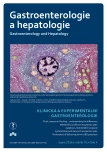Uncommon manifestation of cryptogenic hepatocellular carcinoma
Authors:
P. Klvaňa Jr 1; M. Olbrechtová 1; M. Loveček 2; B. Budínská 3; P. Vítek 1
Authors‘ workplace:
Beskydské gastrocentrum, Interní oddělení, Nemocnice ve Frýdku-Místku, p. o.
1; I. chirurgická klinika LF UP a FN Olomouc
2; Radiologické oddělení, Nemocnice Třinec, p. o.
3
Published in:
Gastroent Hepatol 2016; 70(4): 331-334
Category:
Hepatology: Case Report
doi:
https://doi.org/10.14735/amgh2016csgh.info08
Overview
Hepatocellular carcinoma is the sixth most common cancer worldwide; however, in our region, it is less frequent and occurs almost exclusively in patients with liver cirrhosis. About 10% of hepatocellular carcinomas are observed in patients with no history of chronic hepatitis or alcohol abuse and are classified as cryptogenic. Early stages of this disease are usually asymptomatic and are found accidentally or through screening examinations of patients with chronic liver disease. We present a case of a 65 year old men with no history of liver cirrhosis, who was admitted to our department of internal medicine complaining of epigastric pain caused by spontaneous hemorrhage of a cryptogenic hepatocellular carcinoma in the right lobe of his liver.
Key words:
hepatocellular carcinoma – spontaneous hemorrhage – subcapsular liver hematoma
The authors declare they have no potential conflicts of interest concerning drugs, products, or services used in the study.
The Editorial Board declares that the manuscript met the ICMJE „uniform requirements“ for biomedical papers.
Submitted:
10. 12. 2015
Accepted:
24. 1. 2016
Sources
1. Taura N, Ichikawa T, Miyaaki H et al. Frequency of elevated biomarkers in patients with cryptogenic hepatocellular carcinoma. Med Sci Monit 2013; 19(1): 742 – 750. doi: 10.12659/ MSM.889361.
2. International Agency for Research on Cancer. Globocan 2012: Estimated cancer incidence, mortality and prevalence worldwide in 2012. [online]. Available from: http://globocan.iarc.fr/Pages/fact_sheets_cancer.aspx.
3. Zvolský M. Zhoubné nádory v roce 2011. Ústav zdravotnických informací a statistiky ČR. [online]. Dostupné z: www.uzis.cz/ rychle-informace/ zhoubne-nadory-roce-2011.
4. Hsu CY, Lee YH, Liu PH et al. Decrypting cryptogenic hepatocellular carcinoma: clinical manifestations, prognostic factors and long-term survival by propensity score model. PLoS One 2014; 9(2): e89373. doi: 10.1371/ journal.pone.0089373.
5. Llovet JM, Fuster J, Bruix J. The Barcelona approach: diagnosis, staging, and treatment of hepatocellular carcinoma. Liver Transplant 2004; 10 (2 Suppl 1): S115 – S120.
6. Brůha R, Šperl J, Urbánek P et al. Doporučený postup pro léčbu a diagnostiku hepatocelulárního karcinomu. Gastroent Hepatol 2012; 66(2): 83 – 92.
7. Blonski W, Kotlyar DS, Forde KA. Non-viral causes of hepatocellular carcinoma. World J Gastroenterol 2010; 16(29): 3603 – 3615.
8. Ndzengue A, Hammoudeh F, Brutus P et al. An obscure case of hepatic subcapsular hematoma. Case Rep Gastroenterol 2011; 5(1): 223 – 226. doi: 10.1159/ 000326998.
9. Chen ZY, Qi QH, Dong ZL. Etiology and management of hemmorrhage in spontaneous liver rupture: a report of 70 cases. World J Gastroenterol 2002; 8(6): 1063 – 1066.
10. El Youssoufi S, Nsiri A, Salmi S. Liver rupture in peripartum: about 8 cases. J Gynecol Obstet Biol Reprod (Paris) 2007; 36(1): 57 – 61.
Labels
Paediatric gastroenterology Gastroenterology and hepatology SurgeryArticle was published in
Gastroenterology and Hepatology

2016 Issue 4
- Metamizole in perioperative treatment in children under 14 years – results of a questionnaire survey from practice
- Metamizole vs. Tramadol in Postoperative Analgesia
- The Importance of Limosilactobacillus reuteri in Administration to Diabetics with Gingivitis
- Safety and Tolerance of Metamizole in Postoperative Analgesia in Children
Most read in this issue
- A first evaluation of the Septin 9 test in the Czech Republic
- Gastric outlet obstruction and obstructive jaundice as the first symptoms of primary duodenal lymphoma
- Flush, rosacea or blushing – understanding the differences
- Oesophageal bronchogenic cyst
